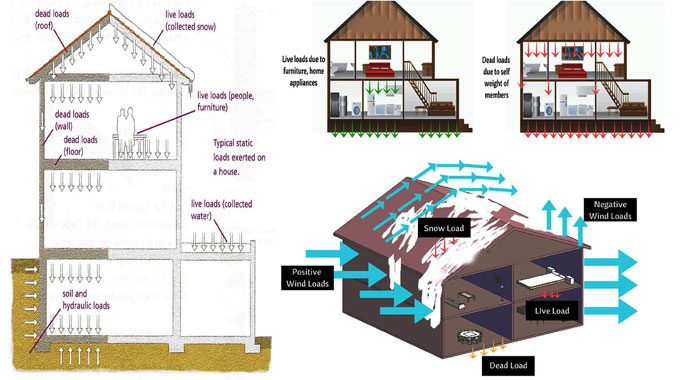
Structural Load Analysis of a Construction
Structural analysis is a significant piece of a design of structures and other constructed resources, for example, scaffolds and passages, as structural loads can cause pressure, twisting and uprooting that may bring about structural issues or even disappointment.
The structure guidelines necessitate that structures must be designed and worked to have the option to withstand all load types that they are probably going to look at during their lifecycle.
There are various sorts of load that can follow up on a structure, the nature of which will change as indicated by the design, use, area and materials being utilized. Design necessities are commonly indicated as far as the greatest loads that a structure must have the option to withstand.
Loads are commonly named either dead loads (DL) or live loads (LL). Dead loads allude to the structure's self weight and for the most part stay consistent during the structure's life. Live loads, for example, traffic loads may fluctuate.
Loads may likewise be classified as:
Concentrated loads (or point loads): Single loads that demonstration over a generally little zone, for example, column loads.
Line loads: Loads apply a load along a line, for example, a parcel's weight on the floor.
Distributed (or surface) loads: These apply a load over a surface zone, for example, the heaviness of floors and roofing materials.
Dead loads (DL): Dead loads, otherwise called perpetual or static loads, are those overwhelmingly connected with the heaviness of the structure itself, and thus stay stationary and moderately consistent after some time. Dead loads may incorporate the heaviness of any structural components, lasting non-structural segments, relentless installations, for example, plasterboard, worked in cabinets, etc.
Dead loads can be determined by evaluating the loads of materials indicated and their volume as appeared on drawings. This implies in principle, it should be conceivable to figure dead loads with a decent level of exactness. In any case, structural engineers are in some cases preservationist with their evaluations, limiting potential diversions, permitting a room for give and take and taking into account adjustments after some time, thus design dead loads frequently far surpass those accomplished by and by.
Live loads (LL): Live loads, otherwise called forced loads, are typically transitory, alterable and dynamic. These incorporate loads, for example, vehicle traffic, inhabitants, furniture and other gear. The power of these loads may shift contingent upon the hour of day, for instance a place of business may encounter expanded live loads during week-day work hours however a lot littler loads during the night or at ends of the week.
Live loads might be concentrated or distributed and may include effect, vibration or speeding up.
Environmental loads: Environmental loads may follow up on a structure because of topographic and climate conditions.
Wind load (WL): Wind loads can be applied by the development of air comparative with a structure, and analysis draws upon a comprehension of meteorology and optimal design just as structures. Wind load may not be a noteworthy worry for little, enormous, low-level structures, however it picks up significance with tallness, the utilization of lighter materials and the utilization of shapes that may influence the progression of air, normally rooftop structures. Where the dead weight of a structure is lacking to oppose wind loads, extra structure and fixings might be required.
A structure's design wind speed is generally decided from chronicled records utilizing outrageous worth hypotheses to anticipate bizarre wind speeds that may happen later on.
Specific impacts that should be considered may include Corner streams or flies that happen around the corners of structures. Vortex shedding that happens in the wake of a structure. Through-stream, or section flies, that happens in an entry through a structure or little hole between two structures.
In complex circumstances, it might be important to embrace wind burrow testing of building structures to evaluate the adjustment in wind streams brought about by the nearness of a structure. Progressively, analysis is likewise conceivable utilizing computational liquid elements programming.
Snow load (SL): This is the load that can be forced by the aggregation of snow and is to a greater degree a worry in geographic locales where snow falls can be substantial and visit. Noteworthy amounts of snow can aggregate, adding a sizable load to a structure. The state of a rooftop is an especially significant factor in the greatness of the snow load. Snow falling on a level rooftop is probably going to aggregate, while snow is bound to fall of a more extreme the rooftop pitch. This might be comparable issues in regions of substantial precipitation where ponding may happen.
Earthquake load: Noteworthy flat loads can be forced on a structure during an earthquake. Structures in zones of seismic movement should be deliberately investigated and designed to guarantee they don't come up short if an earthquake ought to happen.
Thermal loads: All materials extend or contract with temperature change and this can apply huge loads on a structure. Development joints can be given at points on long segments of structures, for example, dividers and floors so components of the structure are truly isolated and can grow without causing structural harm.
Settlement loads: Stresses can happen in structures in the event that one section settles more than another. An adaptable structure will have the option to oblige the little burdens, though a solid structure will require cautious design to mitigate the more extreme anxieties that might be applied.


